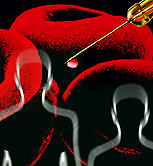One Gene May Be Key to Myeloma
The discovery holds promise as a treatment target for this diverse disease, experts say.
By Amanda Gardner
HealthDay Reporter
|
E-mail this article
Subscribe to news
Printer friendly version
|

(SOURCES: Louis Staudt, M.D., Ph.D., chief, Lymphoid Malignancies Section, Metabolism Branch, Center for Cancer Research, National Cancer Institute, Bethesda, Md.; Bart Kamen, M.D., Ph.D., executive vice president and chief medical officer, The Leukemia & Lymphoma Society; Mitchell Smith, M.D., Ph.D., head of lymphoma service, Fox Chase Cancer Center, Philadelphia; Nature)
MONDAY, June 23 (HealthDay News) -- Cancerous myeloma cells are so "addicted" to a gene known as IRF4, they simply can't live without it, new research has revealed.
Reducing the activity of the gene by only 50 percent is enough to kill myeloma cells without compromising other healthy activities, said scientists reporting in the current issue of Nature.
"This pathway is so critical to the growth of myeloma that, potentially, if you turn it off, you've found a chink in the armor," said Dr. Bart Kamen, executive vice president and chief medical officer at The Leukemia & Lymphoma Society.
The gene could present a target for future drug development.
"IRF4 is absolutely a target in myeloma. This is not an easy target but not an impossible target," said Dr. Louis Staudt, senior author of the paper and chief of the Lymphoid Malignancies Section, Metabolism Branch, Center for Cancer Research at the U.S. National Cancer Institute.
"It's obviously a little bit away, but we have the ability to fairly quickly figure out how to block [genes]," added Dr. Mitchell Smith, head of the lymphoma service at Fox Chase Cancer Center in Philadelphia.
Multiple myeloma, a cancer of the white blood cells, primarily affects older adults and, partly for that reason, often doesn't have a good prognosis.
What's more, there are least seven different "flavors" of multiple myeloma, each having its own unique genetic abnormalities, Staudt said. "One worries that would mean we'd need different drugs for each of these."
While there has been an explosion in new drugs to treat the disease over the past five to 10 years, there is still no cure, Smith said.
The authors took advantage of a genetic screen devised several years ago. This "Achilles' heel screen" uses RNA interference to spot particularly vulnerable parts of cancer cells
"It allows you to inactivate one gene at a time in a cancer cell and then ask what happens," Staudt explained. "We looked simultaneously at thousands of different genes . . . and then asked which one prevents the proliferation and survival of cancer cells."
In this study, the screen identified one gene, IRF4, which surfaced no matter what type of multiple myeloma the investigators looked at.
"Basically, every type of myeloma cell for which we have in vitro models is completely dependent on IRF4, such that, when we inhibit it, they die a swift death within a few days in the lab," Staudt said. "This is better than we hoped."
Interestingly, however, the gene is not mutated when cancer is present. "In the vast majority of cases, there was absolutely nothing different between the IRF4 gene in cancer cells compared to any normal cells," Staudt said. "They were completely normal, yet the cells were totally dependent."
Of course, this begged the question, why?
IRF4 turns out to be a transcription factor, meaning it regulates gene expression -- how a gene produces proteins. In this case, IRF4 regulated the expression of about 35 other genes, including MYC, a well-known cancer-causing gene.
"We found that this IRF4 transcription factor was turning on MYC, which itself is a transcription factor that was turning on IRF4. So, you can see that this is a vicious cycle," Staudt explained. "They cycle out of control, and so this is at least part of how it works."
IRF4 is in charge of so many processes, in fact, that the study authors described knocking it out as "death by a thousand cuts."
"If IRF4 is a master regulator of the working of a myeloma cell, this would be a great drug," Staudt said. "We want people to sit up and take notice of IRF4, because it would be effective across the board in all types of myeloma."
More information
Visit The Leukemia & Lymphoma Society  for more on multiple myeloma.
for more on multiple myeloma.
Copyright © 2008 ScoutNews, LLC. All rights reserved. 
HealthDayNews articles are derived from various sources and do not reflect federal policy. healthfinder.gov does not endorse opinions, products, or services that may appear in news stories. For more information on health topics in the news, visit the healthfinder.gov health library.